June 2022
- PREVIOUS
- NEXT
- English
- 日本語
The Appeal of Washoku Created by Umami

Fushiki Toru, Chairperson of the Washoku Association of Japan and Vice President of Koshien University 
Katsuobushi, skipjack tuna that has been dried, fermented and smoked, and is shaved to make dashi stock
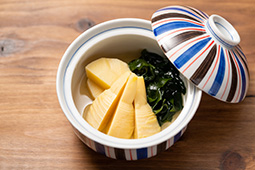
Wakatakeni, bamboo shoots simmered in dashi and seasonings such as soy sauce and sake 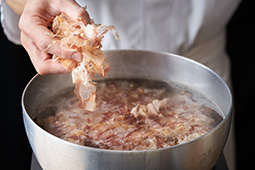
Katsuobushi shavings are added to a dashi made from konbu (kelp) to create awase dashi stock 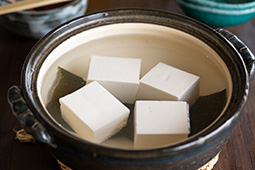
A pot of yudofu—tofu simmered with a strip of konbu (kelp) 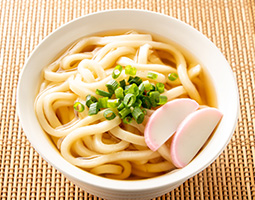
Udon noodles 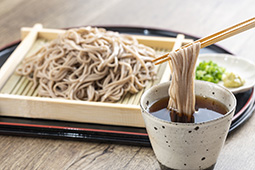
Zaru-soba (chilled buckwheat noodles) and tsuyu dipping sauce 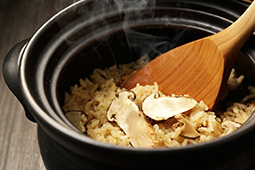
Takikomi gohan, white rice steamed with a variety of ingredients, here with matsutake mushrooms 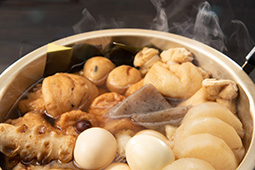
Oden, a winter dish of various ingredients slowly simmered in a tsuyu stock

We spoke with Fushiki Toru, Chairperson of the Washoku Association of Japan and Vice President of Koshien University, about the characteristics of washoku (traditional Japanese meals) and the umami that forms the foundation of its flavors.

In 2013, “Washoku, traditional dietary cultures of the Japanese,” was inscribed on UNESCO’s Representative List of the Intangible Cultural Heritage of Humanity. What exactly is the “washoku” that made it onto this list?
The “washoku” that was inscribed as an Intangible Cultural Heritage does not represent specific dishes like sushi or tempura; it refers to the traditional dietary cultures that have been cultivated by the Japanese over many years. Now that prompts the question, what are those traditional dietary cultures of the Japanese? They can be described as having four characteristics. The first is using a rich variety of ingredients and showing respect for their inherent flavors. With its abundance of nature, Japan features a diverse range of ingredients. Each region has its own specialties, and the inherent flavors of those ingredients have always been utilized to produce a variety of regional cuisines across Japan. The second is the healthy variety of dishes with an excellent nutritional balance. The traditional style of a washoku meal, known as ichiju sansai (one soup and three dishes)*, has an excellent nutritional balance. The third characteristic is how washoku expresses the beauty of nature and the changing seasons. By using seasonal ingredients and garnishing dishes with flowers and leaves associated with each season, one can taste a sense of each season. The fourth trait is washoku’s intimate relationship with annual celebrations such as New Year. At New Year and many other annual events, an array of dishes are prepared in hopes of a bountiful harvest and good health.

Something that plays an important role in supporting this dietary culture is dashi (soup stock). Dashi is used not only in traditional Japanese cuisine but in dishes such as curry and ramen noodles. Dashi contains umami (see later in this article). Japanese dashi is mainly made from konbu (dried kelp), katsuobushi (skipjack tuna that has been dried, fermented and smoked), and niboshi (dried small fish such as sardines). There are also various forms of dashi overseas, such as French bouillon broth and Chinese gao tang stock created by simmering meats, vegetables and various ingredients for an extended time. The umami produced from dashi elevates the taste of dishes around the world.
What kinds of flavors are produced by traditional Japanese cuisine utilizing dashi?
For many years I have been running culinary research sessions with chefs of Kyoto’s fine dining establishments called ryotei which serve traditional Japanese dishes. The sense I get from these chefs after listening to them talk and tasting their food is how they aspire to create “unembellished flavors.” By unembellished, I mean flavors that draw on the inherent flavors of each ingredient while achieving comfortable and harmonious flavors. You could describe them as mellow flavors without showiness or fancifulness. To bring out these flavors, traditional Japanese cuisine emphasizes the preparation of the ingredients. To preserve their inherent flavors, the ingredients are washed, sometimes boiled in sake (rice wine), and stripped of any flavors that could disturb the harmony of the dish in the slightest way. During cooking, any scum that rises to the surface and which would produce unpleasant flavors is also thoroughly removed. Then in the final step of cooking, dashi is used to bring all of the flavors into harmony.

I am very fond of dishes that let one taste the umami of the dashi. One such example is wakatakeni. Wakatakeni is a dish of bamboo shoots simmered in dashi and seasonings such as soy sauce and sake. You enjoy not only the umami flavors, but the texture of the bamboo shoots. As bamboo shoots are an ingredient that represents spring, when we enjoy wakatakeni, we can experience spring.
I’ve heard that the umami produced from dashi was discovered in Japan. Can you explain some more about umami?
Umami was discovered in 1908 by Dr. Ikeda Kikunae (1864–1936), a professor at Tokyo Imperial University (now the University of Tokyo). It is said that the source for this discovery is yudofu (boiled tofu), which is a standard winter dish in Japan. Yudofu is a simple dish that is eaten after heating tofu in hot water containing konbu. One day, when Dr. Ikeda was eating yudofu, he sensed a flavor that was neither sweet nor salty, and wondered what it was. Believing it to be a flavor produced by the konbu, Dr. Ikeda purchased a large amount, and boiled it in hot water to create a konbu dashi broth. Then, he concentrated the broth to extract its ingredients. He subsequently discovered that the ingredient was monosodium glutamate (hereinafter, glutamic acid). Believing that the flavor was the fifth flavor following the four basic flavors of sweet, salty, bitter and sour that humans had known about since ancient times, he named it “umami.” Soon after, another Japanese scientist discovered that the inosinic acid contained in katsuobushi and niboshi was also an umami ingredient. While glutamic acid is found in cheese, tomato and potatoes and other foods, and inosinic acid can be found in things like pork and beef, their concentrations are small compared with the likes of konbu, katsuobushi and niboshi.

Umami underpins the flavors in a dish and makes them taste better. However, unlike sweet and salty, since umami lacks a clearly defined taste, it is hard to describe its flavor in words. The way to enable umami to be tasted clearly is to combine a dashi made from konbu and a dashi made from katsuobushi. This awase dashi boosts the umami flavor many times over by combining the glutamic acid and inosinic acid together. I create opportunities to try this awase dashi at university lectures and washoku-related events, and everyone, from adults to children, are surprised by how delicious it is.

Why are there so many dishes that utilize umami in Japan?
Two of the important elements that determine the deliciousness of a food are fat and sugar. But due to the influences of Buddhist precepts, many Japanese did not eat meat until the Meiji period (1868–1912). That’s why little of the fat contained in meat was consumed. Until the Meiji period sugar was also considered a luxury good, and the general population had few opportunities to taste it. Under these dietary lifestyles that for the most part lacked fat and sugar, the Japanese found umami as a way to make foods taste better. Fortunately, as a nation surrounded by the sea on all sides, Japan had access to rich marine resources including konbu and skipjack tuna. In addition to the rice and vegetables cultivated in the fields, a wide range of mushrooms and wild vegetables were also collected from the mountain areas. The Japanese have constantly innovated to create umami from these various ingredients. For example, fermented foods such as miso and soy sauce which are made from soybeans and other ingredients are packed full of umami. By lacking opportunities to eat meat and sugar, Japan went in the other direction, leading to diversity in ingredients and the widespread development of dashi.

Although it depends on the individual, many people born and raised in Japan tend to like dishes with the umami of dashi made from konbu and katsuobushi. About twenty years ago I spent about a month in the United States for research purposes. At the time, there were almost no Japanese restaurants in the small cities I visited in the central and southern areas of the country. That’s why I always yearned to eat Japanese food during my stay. Then, when the day came to return to Japan from the US, I arrived at an airport in Seattle on the West Coast thinking that I only had to be a little more patient before I could eat Japanese food again, but to my surprise, there was a restaurant serving udon noodles**. With the aroma of the katsuobushi dashi used in the tsuyu (soup) of udon dishes drifting in the air, I noticed many Japanese people eating udon there and joined them without hesitation. The udon was really delicious, and I was left very satisfied. At the time, I conjectured that dashi has a deliciousness that makes people addicted to it. Later, when my research group conducted tests using mice, we learned that the mice exhibited a strong desire for dashi, not to the same degree as fat, but as much as that for sugar.
Fats and sugars serve as a source of energy for us and they are essential for life support. As humans we instinctively desire them, so it is extremely difficult to stop consuming them. But since fats and sugars are high in calories, excessive intake can have an adverse impact on health. Dashi, on the other hand, despite being extremely low in calories, satisfies our appetite and leaves us feeling content much like fat and sugar does. In other words, utilizing dashi, we can curb intake of fats and sugars and create dishes that are not only low in calories, but which are also very satisfying. Japanese and foreigners alike have the impression that “Japanese dishes are healthy and delicious,” and that is precisely the case.

Once the COVID-19 pandemic subsides, which kinds of Japanese cuisine do you hope that foreign visitors to Japan will enjoy?
I hope that in addition to popular genres of Japanese food like sushi and ramen, that they will try dishes that enable them to fully savor the deliciousness of umami, qualities that are not always available to the same degree outside Japan. One example is a soup-based dish known as osuimono (clear soup). It is a simple dish with a soup made of soy sauce and salt added to dashi, with ingredients such as vegetables and shiitake mushrooms, but it allows one to experience the umami of dashi in powerful terms. I would also recommend soba (buckwheat noodles)*** and udon. Both are popular foods with the Japanese, and there are many different restaurants serving them across Japan. As with udon, the tsuyu for soba is also primarily made from dashi and soy sauce.
Along with the wakatakeni I mentioned earlier, takikomi gohan is another big favorite of mine and something I hope visitors try. This is a dish in which white rice is steamed together with vegetables, shiitake mushrooms, meat, fish or other ingredients, with dashi and seasonings such as soy sauce added during the process. Takikomi gohan can be enjoyed at restaurants serving traditional Japanese dishes as well as at izakaya dining bars. A delicious option during winter is oden, a dish in which various ingredients such as daikon radish and eggs are slowly simmered in a tsuyu made from a mixture of dashi and seasonings such as soy sauce and sake.

Japanese cuisine may include some dishes that foreign visitors are not accustomed to eating, but I encourage everyone to try new things with an open mind. I hope diners will not only enjoy the flavors, but also the beautiful presentation and sense of seasonality in the dishes.
* See Highlighting Japan January 2021: Food and Dishware as Landscapes https://www.gov-online.go.jp/eng/publicity/book/hlj/html/202101/202101_02_en.html
** Udon is a white noodle generally made by kneading wheat flour with salt and water, and is usually eaten in a tsuyu (soup). Although wheat flour is also a raw ingredient in ramen noodles, it is made by adding an alkaline kansui (lye water) solution.
*** Soba noodles are made from buckwheat flour, giving them a distinctive brownish color. Soba is enjoyed in two main ways, either in a bowl containing a hot soup or as zaru-soba, where the soba noodles are chilled, and served on a zaru (tray) with a tsuyu dipping sauce.
- PREVIOUS
- NEXT

